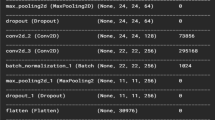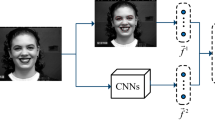Abstract
In this research work, a new Image super-resolution-based Face Emotion Recognition Model has been introduced. The proposed work includes two major phases: (a) Facial image super-resolution and (b) Facial emotion recognition. Initially, the collected facial image is subjected to the facial image super-resolution phase, where the Higher Resolution (HR) facial images are subjected to two-dimensional canonical correlation analysis (2D CCA). The acquired HR facial images are considered as the input for facial emotion recognition. From the acquired HR facial images, the face region alone (lips, eyes, and cheeks) is detected by Viola-Jones facial detection model. Subsequently, from the acquired facial regions, the most relevant features like proposed “Geometric Mean based Weighted Local Binary Pattern (GM-WLBP), Gray Level Co-occurrence Matrix (GLCM)” and generalized low-rank model (GLRM) features are extracted. Then, Principal Component Analysis (PCA) technique is applied to solve the curse of dimensionality. Finally, the reduced dimensional features are given to the emotion classification phase to classify the emotions as sad, happy, fear, rage, disgust, and surprise. The proposed hybrid classifier framework includes the renowned Long-Short Term Memory Network (LSTM) and Convolutional Neural Network (CNN) models. These deep learning models is separately trained using the dimensionally reduced features, and the outcomes are combined. Then, the mean value is computed on the final combined outcome (output of LSTM+ output of CNN), which results in the type of emotions. To enhance the classification accuracy, the weight of CNN is fine-tuned by a new Improved Tunicate swarm Optimization Model (ITSA), which is the conceptual improvement of standard Tunicate swarm Optimization (TSA). The performance of the proposed work is evaluated over the existing model to show the supremacy of the proposed work.






Similar content being viewed by others
References
Amiri M, Ahmadyfard A, Abolghasemi V (2019) A fast video super resolution for facial image. Signal Process Image Commun
An L, Bhanu B (2014) Face image super-resolution using 2D CCA. Signal Process 103
Anita JS, Abinaya JS (2019) Impact of supervised classifier on speech emotion recognition. Multimed Res 2(1):9–16
Cai J, Han H, Shan S, Chen X (2020) FCSR-GAN: joint face completion and super-resolution via multi-task learning. IEEE Trans Biom Behav Identity Sci 2(2):109–121. https://doi.org/10.1109/TBIOM.2019.2951063
Cao L, Liu J, Du K, Guo Y, Wang T (2020) Guided cascaded super-resolution network for face image. IEEE Access 8:173387–173400. https://doi.org/10.1109/ACCESS.2020.3025972
Chen L, Pan J, Li Q (2019) Robust face image super-resolution via joint learning of subdivided contextual model. IEEE Trans Image Process 28(12):5897–5909. https://doi.org/10.1109/TIP.2019.2920510
Chen J, Chen J, Wang Z, Liang C, Lin C-W (2020) Identity-aware face super-resolution for low-resolution face recognition. IEEE Signal Process Lett 27:645–649. https://doi.org/10.1109/LSP.2020.2986942
Chen L, Pan J, Jiang J, Zhang J, Wu Y (2020) Robust face super-resolution via position relation model based on global face context. IEEE Trans Image Process 29:9002–9016. https://doi.org/10.1109/TIP.2020.3023580
Chen L, Pan J, Hu R, Han Z, Liang C, Wu Y (Dec. 2020) Modeling and optimizing of the multi-layer nearest neighbor network for face image super-resolution. IEEE Trans Circuits Syst Video Technol 30(12):4513–4525. https://doi.org/10.1109/TCSVT.2019.2917511
Chen C, Gong D, Wang H, Li Z, Wong K-YK (2021) Learning spatial attention for face super-resolution. IEEE Trans Image Process 30:1219–1231. https://doi.org/10.1109/TIP.2020.3043093
Chen K, Franko K, Sang R (2021) Structured model pruning of convolutional networks on tensor processing units, arXiv preprint arXiv:2107.04191
Darekar RV, Dhande AP (2019) Emotion recognition from speech signals using DCNN with hybrid GA-GWO algorithm. Multimed Res 2(4):12–22
Farrugia RA, Guillemot C (Sept. 2017) Face hallucination using linear models of coupled sparse support. IEEE Trans Image Process 26(9):4562–4577. https://doi.org/10.1109/TIP.2017.2717181
Grm K, Scheirer WJ, Štruc V (2020) Face hallucination using cascaded super-resolution and identity priors. IEEE Trans Image Process 29:2150–2165. https://doi.org/10.1109/TIP.2019.2945835
Hu X, Fan Z, Xuan Z (2021) Towards effective learning for face super-resolution with shape and pose perturbations. Knowl-Based Syst
Ismail M, Anjum G Reddy TB (2020) Variable block size hybrid fractal technique for image compression. Proceedings IEEE 6th International Conference on Advanced Computing & Communication Systems, pp 510–515
Jiang J, Ma J, Chen C, Jiang X, Wang Z (2017) Noise robust face image super-resolution through smooth sparse representation. IEEE Trans Cybern 47(11):3991–4002. https://doi.org/10.1109/TCYB.2016.2594184
Jiang J, Chen C, Ma J, Wang Z, Wang Z, Hu R (2017) SRLSP: a face image super-resolution algorithm using smooth regression with local structure prior. IEEE Trans Multimed 19(1):27–40. https://doi.org/10.1109/TMM.2016.2601020
Kaura S, Awasthia LK, Sangala AL, Dhimanb G (2020) Tunicate Swarm Algorithm: a new bio-inspired based metaheuristic paradigm for global optimization. Eng Appl Artif Intell 90
Koulierakis I, Siolas G, Efthimiou E, Fotinea E, Stafylopatis A-G (2020) Recognition of static features in sign language using key-points. In Proceedings of the LREC2020 9th Workshop on the Representation and Processing of Sign Languages: Sign Language Resources in the Service of the Language Community, Technological Challenges and Application Perspectives, pp 123–126
Kumar Gola K, Chaurasia N, Gupta B, Singh Niranjan D (2021) Sea lion optimization algorithm based node deployment strategy in underwater acoustic sensor network. Int J Commun Syst 34(5):e4723
Li J, Zhou Y, Ding J, Chen C, Yang X (2020) ID preserving face super-resolution generative adversarial networks. IEEE Access 8:138373–138381. https://doi.org/10.1109/ACCESS.2020.3011699
Li M, Zhang Z, Yu J, Chen CW (2021) Learning face image super-resolution through facial semantic attribute transformation and self-attentive structure enhancement. IEEE Trans Multimed 23:468–483. https://doi.org/10.1109/TMM.2020.2984092
Liu B, Ait-Boudaoud D (2019) Effective image super resolution via hierarchical convolutional neural network. Neurocomputing
Liu Z-S, Siu W-C, Chan Y-L (2019) Reference based face super-resolution. IEEE Access 7:129112–129126. https://doi.org/10.1109/ACCESS.2019.2934078
Liu L, Wang S, Wan L (2019) Component semantic prior guided generative adversarial network for face super-resolution. IEEE Access 7:77027–77036. https://doi.org/10.1109/ACCESS.2019.2921859
Liu Q, Jia R, Zhao C, Liu X, Sun H, Zhang X (2020) Face super-resolution reconstruction based on self-attention residual network. IEEE Access 8:4110–4121. https://doi.org/10.1109/ACCESS.2019.2962790
Lu T, Xiong Z, Zhang Y, Wang B, Lu T (2017) Robust face super-resolution via locality-constrained low-rank representation. IEEE Access 5:13103–13117. https://doi.org/10.1109/ACCESS.2017.2717963
Lu T, Chen X, Zhang Y, Chen C, Xiong Z (2018) SLR: semi-coupled locality constrained representation for very low resolution face recognition and super resolution. IEEE Access 6:56269–56281. https://doi.org/10.1109/ACCESS.2018.2872761
Lu T, Wang J, Zhang Y (2020) Global-local fusion network for face super-resolution. Neurocomputing 387:309–320
Mohammad I, Harsha Vardhan V, Aditya Mounika V, Padmini KS (2019) An effective heart disease prediction method using artificial neural network. Int J Innov Technol Explor Eng 8(8):1529–1532
Mohammed Ismail B, Shaik MB, Reddy BE (2012) High rate compression based on luminance & chrominance of the image using binary plane technique. J Theor Appl Inf Technol 42(2):191–195
Mohammed Ismail B, Shaik MB, Reddy BE (2015) Improved fractal image compression using range block size. Proceedings of IEEE International Conference on Computer Graphics, Vision and Information Security (CGVIS), pp 284–289
Mohammed Ismail B, Reddy TB, Reddy BE (2016) Spiral architecture based hybrid fractal image compression. IEEE 2016 International Conference on Electrical, Electronics, Communication, Computer and Optimization Techniques (ICEECCOT)
Mohammed Ismail B, Rajesh P, Alam M (2020) A machine learning based improved logisticregression method for prostate cancer diagnosis. Int J Emerg Trends Eng Res 8(9):5693–5698
Mohammed Ismail B, Alam M, Tahernezhadi M, Vege HK, Rajesh P (2020) A machine learning classification technique for predicting prostate cancer. 2020 IEEE International Conference on Electro Information Technology (EIT) July 2020, pp 228–232
Nagar S, Jain A, Kumar A (2020) Mixed-noise robust face super-resolution through residual-learning based error suppressed nearest neighbor representation. Inf Sci 546:121–145
Pei X, Dong T, Guan Y (2019) Super-resolution of face images using weighted elastic net constrained sparse representation. IEEE Access 7:55180–55190. https://doi.org/10.1109/ACCESS.2019.2913008
Potamias R-A, Siolas G, Stafylopatis A (2019) A robust deep ensemble classifier for figurative language detection. In: International conference on engineering applications of neural networks. Springer, Cham, pp 164–175
Rajakumar B R (2018) Optimization using lion algorithm: a biological inspiration from lion’s social behavior. Evolutionary Intelligence, Special Issue on Nature inspired algorithms for high performance computing in computer vision, Vol. 11, No. 1–2, pages 31–52, DOI: https://doi.org/10.1007/s12065-018-0168-y
Sarkar A (2020) Optimization assisted convolutional neural network for facial emotion recognition. Multimed Res 3(2)
Shahne R, Ismail M, Prabhu CSR (2019) Survey on deep learning techniques for prognosis and diagnosis ofCancer from microarray gene expression data. J Comput Theor Nanosci 16(12):5078–5088
Sharma S Self supervised methods towards human activity recognition. IOSR Journal of Computer Engineering (IOSR-JCE) 22(6):51–56
Shi J, Liu X, Zong Y, Qi C, Zhao G (June 2018) Hallucinating face image by regularization models in high-resolution feature space. IEEE Trans Image Process 27(6):2980–2995. https://doi.org/10.1109/TIP.2018.2813163
Wang H, Hu Q, Wu H (2021) DCLNet: dual closed-loop networks for face super-resolution. Knowl-Based Syst 222:106987
Yan Y, Zhang Z, Wang H (2020) Low-resolution facial expression recognition: a filter learning perspective. Signal Process 169:107370
Yang S, Liu J, Fang Y, Guo Z (2018) Joint-feature guided depth map super-resolution with face priors. IEEE Trans Cybern 48(1):399–411. https://doi.org/10.1109/TCYB.2016.2638856
Yu X, Porikli F (2018) Imagining the unimaginable faces by Deconvolutional networks. IEEE Trans Image Process 27(6):2747–2761. https://doi.org/10.1109/TIP.2018.2808840
Yu X, Fernando B, Hartley R, Porikli F (2020) Semantic face hallucination: super-resolving very low-resolution face images with supplementary attributes. IEEE Trans Pattern Anal Mach Intell 42(11):2926–2943. https://doi.org/10.1109/TPAMI.2019.2916881
Yuan Y-H, Li J (2021) Furong Peng," OPLS-SR: a novel face super-resolution learning method using orthonormalized coherent features". Inf Sci 561:52–69
Yun JU, Jo B, Park IK (2020) Joint face super-resolution and Deblurring using generative adversarial network. IEEE Access 8:159661–159671. https://doi.org/10.1109/ACCESS.2020.3020729
Zhang Y, Tsang IW, Li J, Liu P, Lu X, Yu X (2021) Face hallucination with finishing touches. IEEE Trans Image Process 30:1728–1743. https://doi.org/10.1109/TIP.2020.3046918
Author information
Authors and Affiliations
Corresponding author
Additional information
Publisher’s note
Springer Nature remains neutral with regard to jurisdictional claims in published maps and institutional affiliations.
Rights and permissions
About this article
Cite this article
ullah, Z., Qi, L., Binu, D. et al. 2-D canonical correlation analysis based image super-resolution scheme for facial emotion recognition. Multimed Tools Appl 81, 13911–13934 (2022). https://doi.org/10.1007/s11042-022-11922-3
Received:
Revised:
Accepted:
Published:
Issue Date:
DOI: https://doi.org/10.1007/s11042-022-11922-3




